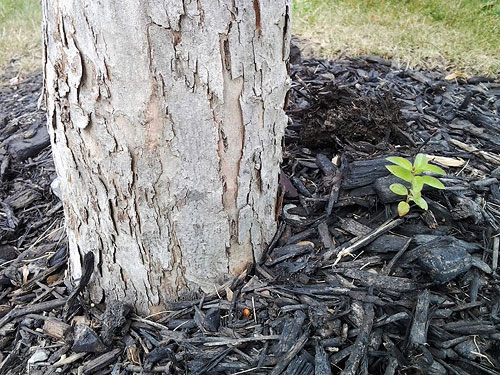On a walk in my neighborhood, I passed by a relatively uneventful river birch standing near the sidewalk in the sunshine. I almost looked the other way when I spotted an interesting relationship happening in the mulch. Living and growing just beyond the trunk and just under its shadow was a small green-leafed tree. I stopped and thought about this natural relationship through the lens of the middle level. The larger tree and its more diminutive companion made me think about the importance of mentoring, which can come in many different shapes and sizes in our middle schools.
Veteran teachers can mentor new teachers. Experienced administrators can guide aspiring school leaders. Families new to middle school can learn from experienced middle level families. Older students can support the academic, social, and behavioral growth of younger students. Sometimes these mentoring relationships can happen organically
School leaders need to celebrate teachers, students, and families who help each other grow every day. We celebrate individual accomplishments—Student of the Month, Employee of the Quarter, Teacher of the Year—but how often do we shine a light on teams and mentors? What would happen to school culture if we had “Mentors of the Year” and “Teams of the Year” celebrations?
And when mentoring doesn’t happen on its own, when a teacher is working in isolation, when certain students are disconnected from others… how do we foster a mentoring mindset in our middle schools? Like these two symbiotic plants, it starts with establishing and recognizing the common ground we share.
Developing a strong school-wide mentoring program begins when we sit down and talk about why mentoring is important for growth. From that natural dialogue, we can develop a common vision and mission for the program. After that vision and mission are created, discussed, revised, and publicized, we need to examine what mentoring looks like—what actions mentors and mentees should take in their relationship to promote growth. These actions become the common guideposts for all mentors in our buildings to follow.
If we are going to have teacher mentors, we need to train them on these actions. If we are going to have student mentors, we need to help them learn about these actions. And if we are going to have parent support mentors, we need to create workshops about these actions. These actions also become the common way we calibrate and recalibrate our commitment to mentoring throughout the year. What’s working? What’s not working? How do we support and retool a mentoring relationship?
Finally, it is critical that we identify the elements in the soil of our schools that cultivate mentoring and growth so we can illuminate and tap into those elements. One of the most vital elements in the common ground for mentoring is time. While we may have common planning time for teams in our schools, do we have a consistent, structured time for mentors and mentees? Unless they are on the same grade level, most mentors have to squeeze in quick chats in the hallways, hasty e-mails between classes, or stolen moments after school.
If we want mentoring to provide the kind of positive, powerful growth that it can, we need to provide time and space for it. The nature of the middle level and the nature of mentoring require and demand our nurturing.
This We Believe Characteristics:
|
Haiku
Growth takes time and warmth
Mentoring a common ground;
Saplings to oak trees
